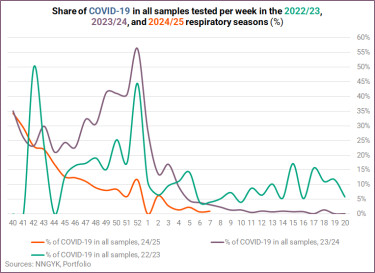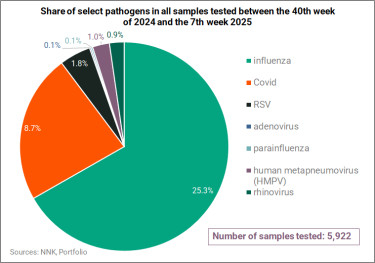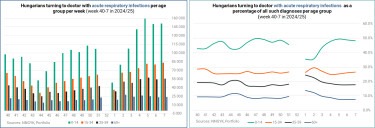Respiratory infections rise in Hungary after promising decline

Key findings:
- More than half (52.4%) of the samples tested on the 7th week of 2025 showed infection with some kind of influenza virus;
- the influenza positivity rate for all samples tested (25.3%) continues to exceed the falling cumulated Covid positivity rate (8.7%), while the flu rate never took the lead in the 2023/24 season;
- the coronavirus positivity rate was up a tad at 1.0% from 0.8%, while
- the RSV positivity rate rose further to 5.0% from 4.7%;
- the number of human metapneumovirus (HMPV) infections reached 59 or 1.0% of all samples tested, which figures compare with 34 and 0.7% a year earlier;
- the number of people hospitalised with severe acute respiratory infection (SARI) rose to 290 from 262, which is higher the comparative figures in the 2023/24 (268) and 2022/23 (275) respiratory seasons;
- 1.7% of those hospitalised tested positive for COVID-19, while there were 118 people with influenza infection in hospital, which corresponds to 40.7% of all SARI patients; and 41 people were treated in hospital with RSV infection (14.1% of all SARI patients);
- of the 290 people in hospital with SARI, 81 (27.9%) were aged two years or younger, slightly down from the 6th week (90 or 34.4%), while 103 (35.5%) were aged 60 years and older, up from 67 or 25.6% on the previous week.
Optimism proved to be premature
With fewer Hungarians going to the doctor with respiratory infection, and in light of the epidemiological pattern of the previous respiratory seasons, we said a week ago that the peak could have been reached. We were wrong, as the latest data attest.
On the 7th week of 2025 (10-16 February), 312,600 people sought medical help with acute respiratory infections (ARI), including 86,800 people with influenza-like illness (ILI), according to data released by the National Centre for Public Health and Pharmacy (NNGYK) on Thursday. The ARI figure rose by 1.7% w/w and the ILI by 5.7%, following declines of 4.7% and 1.8% respectively in the 6th week.
The respiratory season (often and erroneously referred to as 'flu season') generally peaks between the 4th and the 9th week of the year.
A short-term comparison (for the last three seasons of respiratory illnesses) shows that the number of patients with ARI, including those with ILI was much higher than at this point in the previous two respiratory seasons.

The share of influenza-like illness in ARI was up at 27.8% from 26.6% on the 6th week, exceeding the comparative readings from the past two seasons (20.8% and 19.1%, respectively), meaning that effectively more than a quarter of ARI patients showed symptoms of influenza.

We also have data for ARIs and flu-like symptoms per 100,000 inhabitants, although a long-term data series is available only for the latter.
in terms ari is worse and in terms of people with Influenza-like illness per 100,000 people, the situation is currently way worse than in either of the previous two respiratory seasons.


In the graph below you can compare to the flu situation with the previous 13 respiratory seasons, and find that the situation has been worse than currently (yellow line) only once in 2014/15. Perhaps that's what the NNGYK referred to our inquiry a few weeks ago as a "medium-intensity influenza epidemic".

"We also keep a close eye on the rate of serious illness. Currently, 0.09 percent of all patients require hospitalisation. This also shows that the virus currently circulating is not causing more severe illness than we are used to," the NNGYK reassured us in response to our enquiries two weeks ago.
Note that the percentage (hospitalisations divided by the number of people seeking medical help with ARI) was actually 0.098% on the 5th week or, let's round it up a bit, 0.1%. It was indeed a smidge lower than in 2023/24 (0.107% and 2022/23 (0.102%). On the 7th week, the ratio edged up to 0.093% from 0.085%, matching the comparative figure from a year ago.

Positivity rates
A total of 496 samples were tested on the 7th week, down from the record of 515 samples on the 6th week, with 5 coming back COVID-19 positive. The 1.0% positivity rate compares with 3.1% (11 cases) a year ago and 4.1% (7 cases) two years ago.

The share of influenza (52.4%) in the tested samples is well above the previous two years' respective prints (36.5% and 41.3%, respectively), while that of respiratory syncytial virus (RSV) remains lower at 5.0% than in 2023/24 (10%) and 2022/23 (12.8%).


The following graph may seem a bit fuzzy at first but at least it shows a side-by side comparison of the weekly positivity rates for influenza (green), Covid (orange), and RSV (blue) for the past three respiratory seasons up to the 7th week. It is evident how the flu positivity rate stands out this year, whether we compare it to the corresponding rates in the previous two years or to the Covid and RSV positivity rates.

As regards the individual positivity rates in all the samples, the 'switch' never took place in the 2023/24 respiratory season (i.e. the total number of positive Covid tests in all samples tested remained higher than the number of positive flu tests) in and occurred by the end of the 3rd week in the 2022/23 season.
As the chart below attests, SARS-CoV-2 is no longer the main pathogen in samples, with 517 positive tests (8.7% of the 5,922 samples tested), as influenza has been in the lead (since the 4th week) with 1,500 positive samples by week 7 (25.3% of all samples), followed by RSV (109), human metapneumovirus (HMPV, 59), rhinovirus (51), parainfluenza (6), adenovirus (5), and bocavirus (4).

Hospitalisations
290 people with severe acute respiratory infection (SARI) were hospitalised on the 7th week of 2025, of whom 43 (or 14.8%) required intensive care. This is the highest number of SARI patients in ICU in the current respiratory season. On the 7th week in the previous two respiratory seasons 10.4% and 11.3% of SARI patients were treated in ICUs, respectively.

Further breakdown shows that 5 people (1.7% of SARI patients) were hospitalised with SARS-CoV-2 infection, down from 6 a week earlier and way less than either a year ago (20, 7.5%) or two years ago (31, 11.3%).

A total of 118 people in hospital with SARI tested positive for influenza, which corresponds to 40.7% of all SARI patients.
This compares with 65 influenza patients (24.3% of all SARI patients) in hospital on the 7th week of 2024 and 30 (10.9%) on the same week of 2023.

The share of RSV patients edged down to 14.1% (41) from 15.3% (40), which compares with 22% (59) a year earlier and 18.5% (51) two years earlier.

Age distribution of hospitalised SARI patients
Of the 290 people in hospital with SARI, 81 (27.9%) were aged two years or younger, which shows a retreat from 90 (34.4%) a week earlier, while 103 (35.5%) were aged 60 years and older, a sharp increase from the 6th week (67 or 25.6%).

One of the five COVID-19 patients were over 60 years of age. A year ago, of the 268 people in hospital with SARI, 112 (41.8%) were aged two or younger, while 72 (26.9%) were 60 or older. Also, 14 (70%) of the 20 COVID-19 patients were over 60 years of age.

The age breakdown of people seeking medical help with ARI and flu-like symptoms are shown below.
The majority of ARI patients belonged in the 0-14 age group throughout the 'flu season' last year (and so far this year too), while the share of people going to the doctor with flu-like symptoms was the highest in the 15-34 age group up to the 2nd week of last year when the youngest were in majority for nine weeks and then it was back and forth between the 13th and 20th week. You fund a heat map for the previous season in one of our previous articles here.
The number and share of children up to 14 years of age remains higher among people with influenza-like illness than the number and share of those in the 15-34 age group, for the fourth week in a row, after a brief switch on the first two weeks of 2025.
some 151,000 of people with ARI and almost 37,000 of people with ILI were in the 0-14 age group on the 7th week of 2025. The former compares with about 142,500 a year earlier, while the latter compares with almost 24,500 in the base period.


Whooping cough remains with us too
The number of suspected pertussis cases does not seem to be dropping, either. Based on the figures for the first six weeks of the year, it looks likely that 2025 will bring another record, unless a dramatic improvement occurs along the way.
The number of suspected whooping cough cases closed at an absolute record of 1,354 cases in 2024. Authorities reported 16 suspected cases for the 6th week of 2025, by which time over 34% of the 85 cases were infants this year. Also, about 47% of the infections were detected in the 0-14 age group and 53% in the 0-19 age group.




A címlapkép illusztráció. Címlapkép forrása: Getty Images








